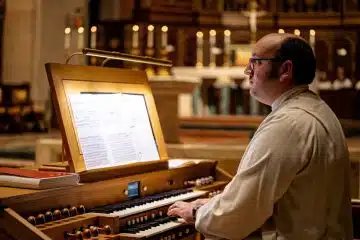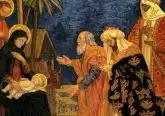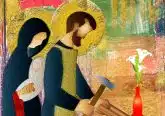Sunday Scripture: Signs of new life at Easter
April 21, 2011
By Father Timothy Schehr
Easter Sunday: Acts 10:34-43; Colossians 3:1-4 or 1 Corinthians 5:6-8; John 20:1-9.
As we make our way to our parishes this Sunday morning we will probably notice signs of life. For weeks now the earth has been taking on more color; the sounds of spring have been growing stronger; and the sun rises earlier in the sky.
The readings for this Easter Sunday will add to our list of signs of life. Let’s begin with the Gospel. Early in the morning Mary Magdalene makes her way to the place where Jesus was buried. It is still dark. When she arrives at the place. she sees that the stone has been rolled away. This is the first sign of life in John’s Resurrection account but Mary does not yet recognize it as a sign of life. She jumps to the conclusion that someone has taken Jesus from the tomb and put His body in another place.
It is noteworthy that she finds Peter and the beloved disciple together. John usually places these two in the same scene. They were near each other at the last supper when Peter motioned to the beloved disciple to learn who the betrayer was. Now they appear together again. They could well have been reflecting on the Lord’s words at the Last Supper. He had already announced to Peter that he would deny Him; He had also said He would return.
When Peter and the beloved disciple arrive at the tomb they see more signs of life. The cloths, so carefully wrapped around the body of Jesus by Joseph of Arimathea and Nicodemus, now lie on the floor of the tomb. And the cloth that once covered the Lord’s head is rolled up in a place by itself, a detail that may suggest the things associated with the Lord’s death are finished. The beloved disciple sees these signs and believes.
John does not record a response from Peter. That will come only in the final chapter of this Gospel. But John does mention another sign of life. He tells his readers the disciples did not yet understand the Scripture that Jesus had to rise from the dead. So the Scriptures themselves become a sign of life for those who understand them. John does not identify any specific passages. He may have had in mind the prophet Ezekiel’s wonderful oracle about God’s faithful people rising from their graves (Ezekiel 37:12). Or perhaps he had in mind the prophet Isaiah’s hymn about the suffering servant who would be raised high and greatly exalted (Isaiah 52:13).
Though silent in the Gospel, Peter has plenty to say in the first reading. On the feast of Pentecost Peter stands before crowds in Jerusalem proclaiming for all to hear the good news about Jesus Christ. Peter is thrilled to be among those proclaiming that Jesus is the Messiah all the prophets looked forward to. This profound transformation in Peter and the rest is another sign of life for us readers.
In the second reading, whether from Colossians or from First Corinthians, Paul encourages his spiritual brothers and sisters to live new lives. Through baptism in the Lord they share in the resurrection. They should seek what is above and think what is above. They are a fresh batch of dough like the unleavened bread of Passover. The old yeast “of malice and wickedness” is no longer of use to them. This dramatic change within their hearts is yet another sign of the new life we celebrate this Easter.
Father Schehr is a faculty member at the Athenaeum of Ohio.













